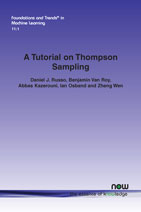A Tutorial on Thompson Sampling
By Daniel J. Russo, Columbia University, USA, djr2174@columbia.edu | Benjamin Van Roy, Stanford University, USA, bvr@stanford.edu | Abbas Kazerouni, Stanford University, USA, abbask@stanford.edu | Ian Osband, Google DeepMind, UK, ian.osband@gmail.com | Zheng Wen, Adobe Research, USA, zwen@adobe.com
Abstract
Thompson sampling is an algorithm for online decision problems where actions are taken sequentially in a manner that must balance between exploiting what is known to maximize immediate performance and investing to accumulate new information that may improve future performance. The algorithm addresses a broad range of problems in a computationally efficient manner and is therefore enjoying wide use. This tutorial covers the algorithm and its application, illustrating concepts through a range of examples, including Bernoulli bandit problems, shortest path problems, product recommendation, assortment, active learning with neural networks, and reinforcement learning in Markov decision processes. Most of these problems involve complex information structures, where information revealed by taking an action informs beliefs about other actions. We will also discuss when and why Thompson sampling is or is not effective and relations to alternative algorithms.
A Tutorial on Thompson Sampling
Thompson sampling is an algorithm for online decision problems where actions are taken sequentially in a manner that must balance between exploiting what is known to maximize immediate performance and investing to accumulate new information that may improve future performance. The algorithm addresses a broad range of problems in a computationally efficient manner and is therefore enjoying wide use.
A Tutorial on Thompson Sampling covers the algorithm and its application, illustrating concepts through a range of examples, including Bernoulli bandit problems, shortest path problems, product recommendation, assortment, active learning with neural networks, and reinforcement learning in Markov decision processes. Most of these problems involve complex information structures, where information revealed by taking an action informs beliefs about other actions. It also discusses when and why Thompson sampling is or is not effective and relations to alternative algorithms.
